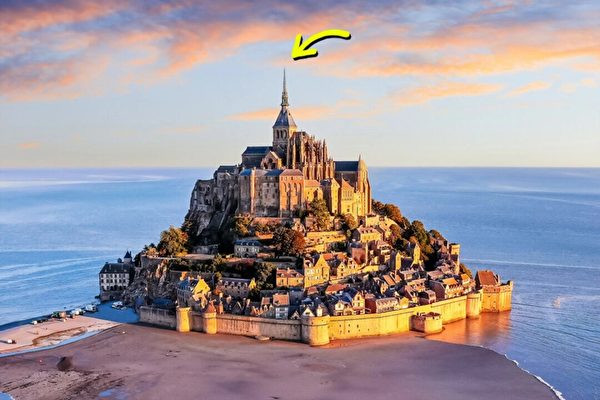The enchanting Tidal Island of Mont Saint-Michel has a history that dates back over 1,300 years. It is one of the most captivating attractions in France. Located 1 km (0.6 miles) off the northwest coast of France, the island is home to a fortress-like monastery and a small village that are truly awe-inspiring.
It may look like a fantastical setting from “Game of Thrones,” and the beloved Mont Saint-Michel was established in the early 8th century with a rich history, being widely recognized as one of France’s premier tourist destinations. The island has a small permanent population of about 25 residents, including monastery monks and nuns.
Situated in the La Manche department of western Normandy, the mountain was initially designed by Bishop Aubert of Avranches. In 708, the bishop erected a temple on the rocks to honor the Archangel Michael, the heavenly being who cast Satan out of heaven. Legend has it that the angel appeared to the bishop three times in visions, each time urging him to establish a sanctuary on the site.
Two hundred years later, the land was handed over by the Duke of Normandy to Benedictine monks, who began constructing a monastery church under the supervision of the renowned Norman king, William the Conqueror. The soaring Romanesque church was completed in the 11th century. With the construction of the Gothic monastery, the surrounding villages also flourished, and at its peak, the mountain was home to 400 residents.
The entire project was structured according to the social hierarchy, making it one of the most challenging architectural endeavors of the Middle Ages. The layout featured God and the church at the top, followed by the monastery, then the halls, shops, and residences, with farmers and fishermen’s houses at the bottom.
In a video by DW Travel, a guide remarked, “It’s hard to believe how they built such structures on this mound of earth. Mont Saint-Michel is like a rock cone, reminiscent of a pyramid. We are almost at the summit at an elevation of 262 feet. Envision a system where boats come and go based on the tides. The medieval construction crews brought materials from various parts of Normandy using boats, essentially barges, some even from England.”
Myth and spiritual fervor surround the towering turrets on the island, attracting Christian pilgrims from afar for centuries. Initially, the coast was farther from the island, a full 4.3 miles (7 kilometers) away. Nevertheless, the monks’ visitors were not deterred.
Today, a 2,500-foot bridge constructed in 2014 has replaced the old traditional causeway, allowing visitors to walk or take a bus to the island. The difference between high and low tides can reach up to 45.9 feet, making crossing the tidal sands without the bridge potentially perilous. Apart from the risk of drowning, there are stretches of deep mud and quicksand.
During the Hundred Years’ War between 1337 and 1453, the French built walls at the base of the island to fend off English invaders, resulting in a decrease in pilgrim numbers.
Several fascinating artifacts exhibit the awe-inspiring past and resilience of Mont Saint-Michel: two wrought-iron cannons abandoned by invaders during a failed siege in 1434 still stand tall outside the walls.
The entrance to the Saint-Pierre parish church built in the 15th and 16th centuries is the location of a statue of Saint Joan of Arc.
This young farm girl from the town of Orleans, like Bishop Aubert centuries before, claimed to have seen miraculous visions from the Archangel Michael. She was deeply moved by the resistance at Mont Saint-Michel and successfully led her troops to repel the English during the Siege of Orleans.
During the French Revolution (1789-1799), the monastery housed hardly any monks. In 1791, the building was repurposed as a prison. About 70 years later, under Napoleon III’s rule, over 600 inmates were transferred elsewhere when it closed.
Writer Victor Hugo visited Mont Saint-Michel in 1836. The literary giant was in awe of its splendor, calling Mont Saint-Michel “…it is, in short, a pyramid.”
Decades later, a movement led by writers prompted Mont Saint-Michel to be declared a historical monument.
Around a century later, in 1979, UNESCO designated Mont Saint-Michel and its bay as a World Heritage Site. Yet for the island’s residents, this remains a vividly living home.
Year after year, the island’s inhabitants and millions of visitors have been gazed upon by the image of the warrior angel Michael, sword raised high, atop the 300-foot Gothic spire.
Translation and Rewriting by Anna Mason, Epoch Times Correspondent / Translated by ZHAO Ziji

